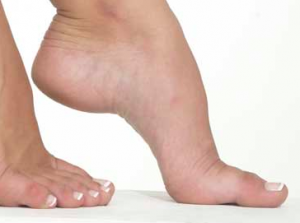 A foot with high arches is often referred to as a pes cavus foot, and usually displays supination during gait, meaning it tends to roll outwards. This can place strain on the heel, ball of the foot and the outside (lateral) foot border. It can also impair the stability of the foot, and increase the chance of spraining your ankle.
It should be noted that having a high arched foot doesn’t mean you are definitely going to develop foot pain or issues, but it does increase your likelihood of developing problems because of the added stress through the bones, joints, muscles and ligaments. Supination is also a natural part of the gait cycle, but in the case of pes cavus feet, this movement is often exaggerated and occurs much earlier in the gait cycle, so is more likely to be problematic.
A foot with high arches is often referred to as a pes cavus foot, and usually displays supination during gait, meaning it tends to roll outwards. This can place strain on the heel, ball of the foot and the outside (lateral) foot border. It can also impair the stability of the foot, and increase the chance of spraining your ankle.
It should be noted that having a high arched foot doesn’t mean you are definitely going to develop foot pain or issues, but it does increase your likelihood of developing problems because of the added stress through the bones, joints, muscles and ligaments. Supination is also a natural part of the gait cycle, but in the case of pes cavus feet, this movement is often exaggerated and occurs much earlier in the gait cycle, so is more likely to be problematic.
What causes high-arched feet?
High-arched feet are typically present from an early age because of the structure of the bones and joints in the feet. In this case, the shape of the foot is expected to stay relatively similar over the course of your life. High arches can develop later in life in association with medical conditions, though this is less common. These conditions include Charcot-Marie-Tooth disease, cerebral palsy, muscular dystrophy, stroke and more. These conditions can progressively worsen and alter the shape of the foot.What are the signs and symptoms?
Pes cavus feet tend to be more rigid and less flexible than a neutral or flat foot. Signs can include:- High arches
- The heel bone (calcaneus) rolling out
- Bulging on the outside of the ankle
- Callus on the outside of the foot
- A greater incidence of toe deformities (claw toes, hammertoes)
- Repeated ankle sprains
- Wearing out the outside of the shoe
- Forefoot pain
- Shortened foot length








